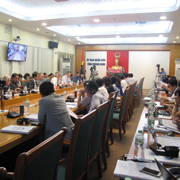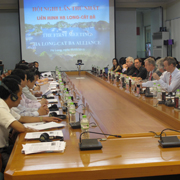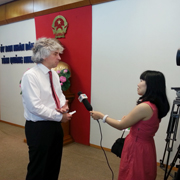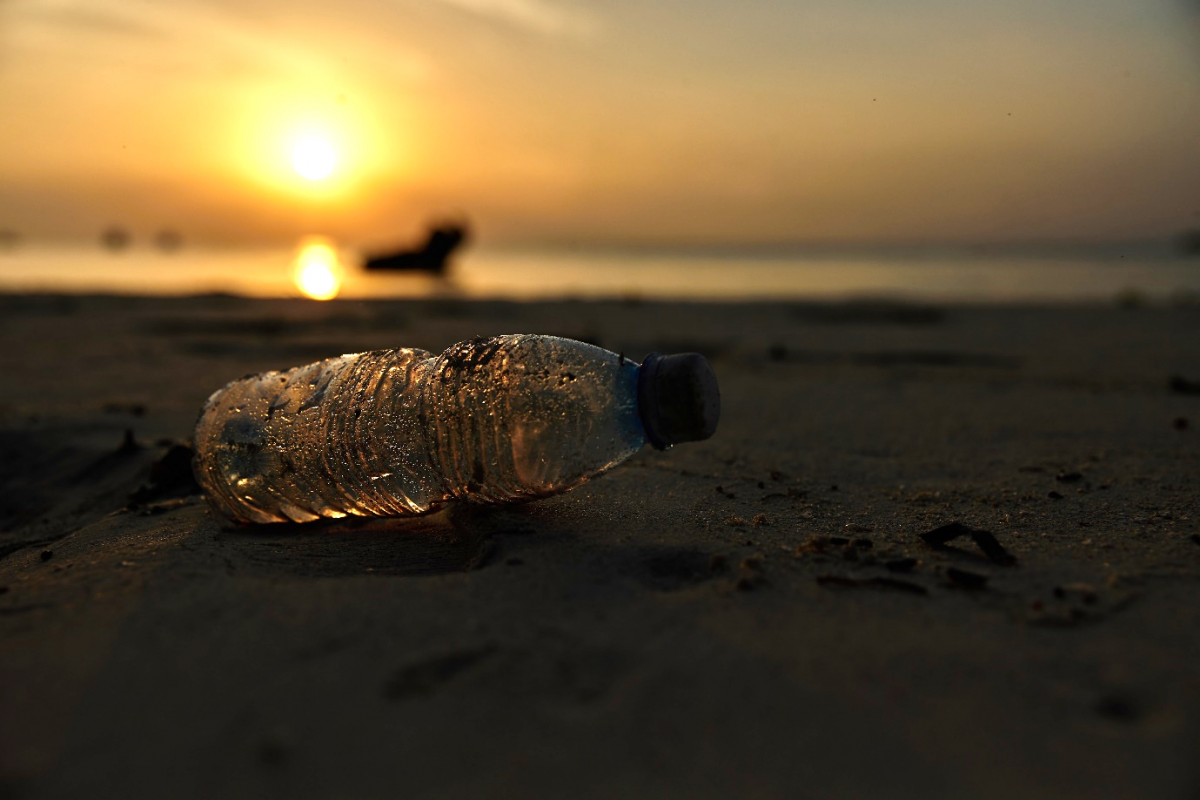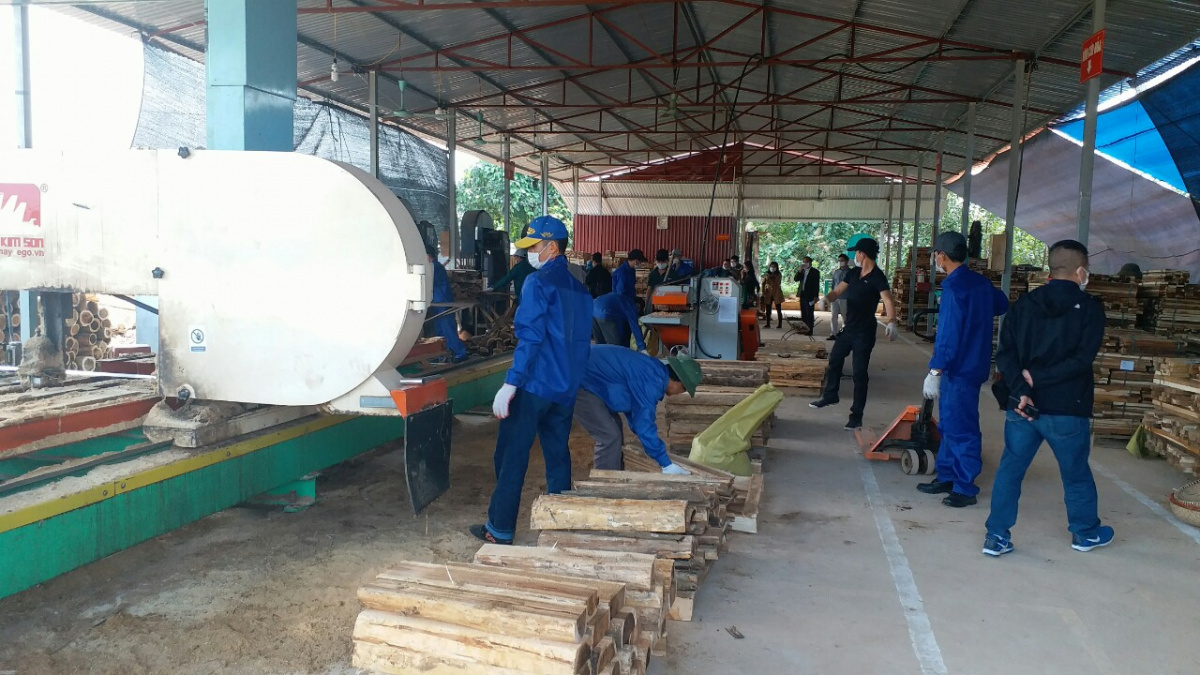Ha Long - Cat Ba Alliance Leadership Committee Meeting
On May 5, IUCN organized the first meeting of the Ha Long-Cat Ba Alliance Leadership Committee in Ha Long City. Funded by USAID, the Alliance was established in April 2014 to bring government, business, and civil society together to address environmental problems in Ha Long Bay. It is modeled on the Chesapeake Bay Alliance (https://allianceforthebay.org/), which was founded in 1971 and fosters multi-stakeholder partnerships to protect the Chesapeake Bay and its rivers and streams.
Originally named the Ha Long Bay Alliance, Cat Ba was added in recognition of the fact that the bay and the Cat Ba Archipelago share the same marine ecosystem. In fact, when the Ha Long Bay World Heritage Site (WHS) was nominated in 1994, IUCN, the official advisor to UNESCO on natural WHS, recommended that the property include Cat Ba. Expanding the WHS to include the archipelago is therefore official IUCN policy and, 21 years later, we have a chance to make this a reality.
The Leadership Committee, which meets twice a year, includes government and business leaders and provide guidance and political support to the Alliance on key policy issues. This first meeting was chaired by the Vice-Chair of the Quang Ninh Provincial People's Committee and U.S. Ambassador Ted Osius. Senior officials from Hai Phong also attended. Business leaders came from General Electric, Grant Thornton, and three of the largest cruise boat companies operating in the bay: Bhaya, Indochina Junk, and Paradise Cruises.
In his opening remarks, the Ambassador said (http://vietnam.usembassy.gov/ambspeech-050515.html): "Addressing environmental issues requires both government and business to meet their responsibilities. Companies that utilize the waters of Ha Long and Cat Ba need to ensure their activities do not harm this resource. Compliance with laws on environmental protection should be considered the minimum effort. For cruise boats, government needs to encourage investment in clean technology by raising environmental standards that give the more advanced companies a competitive edge. Government also needs to be sure that user fees are reinvested—and are seen to be reinvested—in environmental management."
In reviewing project progress, IUCN's Bui Thi Thu Hien presented the results of an analysis of the last 12 months of TripAdvisor reviews. Every day, 2-3 reviews of Ha Long Bay are posted (over 3,500 have been posted to date) and these provide a real-time view of visitor experience. The overdriving impression is that the site is stunning but that the experience is undermined by pollution and overcrowding. In the words of one reviewer: "So good and yet so bad at the same time".
In his presentation, Tim Badman, Director of IUCN's World Heritage Programme, pointed out that Ha Long Bay is not just a WHS but one of the world's best known tourist destinations. It also faces large challenges. Almost every year since 1994, the World Heritage Committee has asked Vietnam to submit a report on the state of conservation, and the next report is due in 2016. A recent IUCN mission confirmed progress had been made on many issues that had been raised by the Committee, including settlement that had encroached in the WHS and in reducing pollution from roads, mines, and other on-shore sources. However further action is needed to tackle the remaining issues that would ensure that Ha Long Bay can be regarded as a world class destination. Clear guidance has also been given by IUCN on the work needed to support a successful extension of Ha Long Bay to include Cat Ba.
The Alliance will initially focus on wastewater from the 500 boats that operate in the bay. These boats produce grey water (which comes from showers and other washing activities), black water (from toilets), and bilge water (which contains oil and originates in the engine rooms). The world's most advanced companies don't discharge any waste water into the sea and bring all their solid waste ashore for recycling, reuse, combustion, or composting by an approved recipient. We need to so the same in Ha Long Bay.
Ken Atkinson, executive chairman of the Vietnam office of Grant Thornton, one of the world's largest independent business consultancies, and co-chair of the Vietnam Tourism Advisory Board, talked about broader tourism trends in Vietnam. The number of international visitors has grown rapidly from a few hundred thousand in 1990 to 7.9 million in 2014. But less than 5% of these are return visitors compared to an estimated 50% in Thailand, which implies a major missed opportunity because Vietnam has just as much to offer in terms of nature and culture as Thailand. What Ken described as an "archaic visa policy" doesn't help but a bigger problem is poor management. TripAdvisor reviews indicate a willingness to pay for longer cruises that take visitors far into the bay where the water is clean and uncrowded. So the length of time a tourist visits and the amount they spend is a better measure of success than the number of tourists.
IUCN's James Hardcastle presented options for a sustainable tourism standard with certification for environmental performance. This would put in place a system that would recognize and reward tour companies for good environmental performance. Such a system would be accredited by the Global Sustainable Tourism Council (https://www.gstcouncil.org/) and audited independently. It could be applied across Vietnam but initially developed for Ha Long Bay. The standard would set a minimum level of performance for all boats operating in the bay and provide higher levels of recognition for boats that meet higher standards. We don't need to start from scratch: existing tour and boat certification models in the Galapagos, Maldives, and Hawaii could be adapted to Ha Long Bay.
The representative from Bhaya (https://www.bhayacruises.com/), one of the largest cruise boat companies, said that it welcomes a certification system and wants to be a partner in defining these standards. Indochina Junk (http://www.indochina-junk.com/) and Paradise Cruises (https://www.paradisecruises.vn/en/index.html) also want to be involved. All three companies have installed advanced waste water treatment systems and are willing to make further investments butneed the government to play its part.
Ambassador Osius pointed out that a milestone in improving water quality in the Chesapeake Bay was the decision by the surrounding states to upgrade waste water treatment systems. In Maryland, every household is billed $5/month to upgrade the state's 66 major sewer plants. Because it would not be cost-effective for boat companies in Ha Long to build their own waste water treatment plants, the government needs to step in. A public-private partnership to provide what economists call a "public good" is therefore indispensible. If the Ha Long Bay Management Department was allowed to retain more than the 18% of the entrance fees than it currently does, it could easily finance such a plant and charge the boat companies to cover the operating expenses.
The representative from the Ministry of Culture, Science, and Technology called for much stricter environmental regulation and the vice-chair, recognizing that fines haven't proved effective, said the government will suspend the operating license of companies that don't comply with waste water treatment rules.
Wrapping up, the Ambassador reiterated the point that improving water qualityand visitor experiencein Ha Long Bay is a shared responsibility that requires action by government, business, and the individual citizens.
The Ambassador also witnessed the signing of an MOU between Quang Ninh, Hai Phong, and IUCN that commits all three parties to cooperate on a range of activities. These include defining an internationally recognized cruise boat certification system and supporting preparatory work to renominate Ha Long Bay to include the Cat Ba Archipelago.
